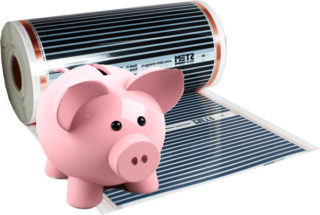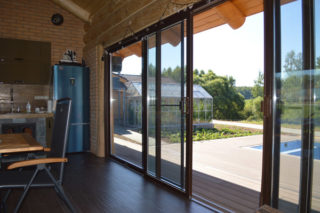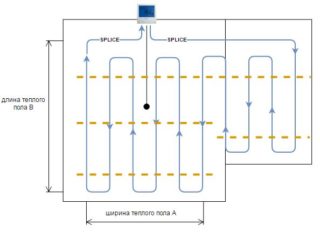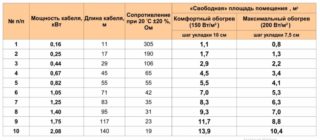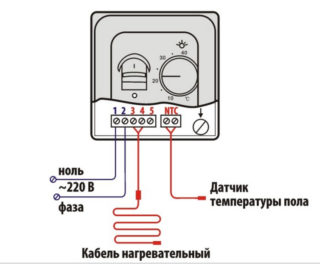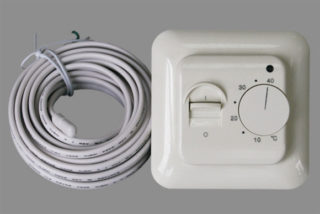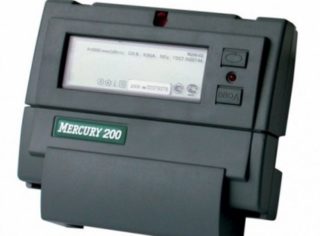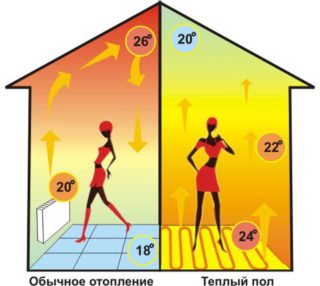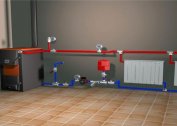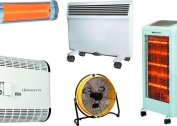Warm floor - an option for electric space heating. In the passport of the system indicate its power consumption per 1 square. m. area. However, this value is the power consumption in the on state, and the heating system operates in cycles. How much electricity a warm floor consumes electricity depends on how much all the nuances of installation and choice are taken into account.
Factors Affecting Electricity Consumption by Underfloor Heating
Electricity is an expensive source of energy, but efficient. If you choose the right heating system, you can provide the house with heat and not spend a lot of money on paying bills.
System view
There are several types of floor electric heater:
- Heating cable - resistive or zonal. The cheapest option. It accumulates a certain amount of heat, after turning off the floor cools down slowly. The laying scheme is complex: the cable can only be placed in open areas, otherwise it overheats and fails. This modification is installed on balconies, loggias, in bathtubs, where heating is required less often.
- Thermomats - convection and infrared. More economical and consume less electricity. Installation requires high qualifications. Thermomats are laid under a thin floor covering, placed in a screed or in a layer of tile glue.
- IR film - heating only due to infrared radiation. In this case, the stage of heat transfer to the coating disappears. Infrared film is more effective. It is mounted in residential premises, where an acceptable temperature must be maintained constantly.
- Self-adjusting - due to the inclusion of carbon-polymer material, the system is self-regulating. In a cold area near the cable, resistance drops, a higher intensity current passes through it and heats it. When heated, the cable resistance increases and the current weakens. This option is designed for the industrial sector, roads in production, but more efficient than other modifications.
Lower energy consumption and cost are not the only factors by which a product is chosen. It is unprofitable to install cable heaters in rooms with a low ceiling; more expensive IR films are mounted here.
External factors
Factors determine the amount of heat loss. The smaller they are, the less powerful heating can be set, and the less you pay for electricity. Consider the following:
- The number of windows and doors - a metal or glass surface conducts heat well. Prevent losses by warming the door.
- The level of resistance to heat loss - the value is an indicator of the wall material - brick, concrete, quality, thickness of the insulating layer, the characteristics of the external and internal finishes. Insufficient thermal insulation negates the benefits of underfloor heating and leads to unnecessary costs.
- Weather conditions - in severe cold, consumption naturally increases.
- The number of residents - the more people live in the apartment, the less the floor heating works.
Infrared film or heating cable can be installed not only on the floor, but also on the walls in a brick building, frame or wooden.
Gender characteristics
The energy consumption of any option of a warm floor is affected by its own indicators:
- the presence of a temperature regulator - the more precisely the temperature is regulated, the more economical the system;
- cable laying step - the smaller it is, the more powerful the heater, the more energy it consumes;
- the thickness of the floor covering - laminate, tile, or screed - the smaller it is, the lower the electricity consumption.
Carpet or carpet reduces the effectiveness of the floor heater and makes it work too actively. The material impedes heat dissipation, which can lead to overheating and damage to the cable. Only small decorative rugs are allowed.
Electric floor consumption calculation
Heating ETP is efficient, but too high energy consumption makes it unprofitable. They calculate the costs, taking into account the operating mode and type of floor heater, otherwise the data will be unreliable.
Total power calculation
An approximate calculation is carried out as follows: multiply the usable area by the power of the electric heated floor by 1 square meter indicated in the product passport. Get the highest possible expense.
However, the floor heater does not work continuously: the cable heats up for 5–20 minutes within an hour. For example, for an area of 12 square meters. m. with a system power of 150 W / sq. m, the maximum consumption will be 1.8 kW per hour. But since the system only works 10 minutes per hour, and 50 minutes it cools, the real consumption will be only 0.3 kW per hour.
The temperature affects in the same way. The maximum temperature of the cable floor is +65 C, IR films - +60 C. Such a high heating is rarely needed. The operating temperature is not more than 30–35 C, that is, the energy consumption is reduced by another 40%.
The degree of warming both increases and decreases energy consumption:
- heating of residential premises requires up to 120 W / sq. m;
- for a bathroom - 150 W / sq. m, since this room is non-residential;
- insulation on the balcony or loggia is the weakest, 200 W / sq. will be required for heating. m
Since the bathroom and the loggia are used much less often than the bedroom or kitchen, the real expense is not so great.
Amendment to work with thermostat
The temperature regulator switches heating on and off, depending on the readings of the temperature sensor. When the air temperature in the room exceeds the set value, the warm floor is turned off; when it falls - the thermostat turns on the heater. Cyclical operation saves energy.
Electronic programmable thermostat provides optimal heating mode. The default settings suggest that in the morning, while all the inhabitants are at home, the temperature must be maintained at 25 C. If the house is empty during the working day, the heating can be reduced to 15 C. In the evening, when the tenants return home, the temperature is raised again. At night, the heating intensity decreases.
Calculation of the cost of resources
Calculating expenses is not difficult. The resulting system capacity for each room and taking into account the work schedule is multiplied by the value of the tariff adopted in the region. Actual consumption may differ if some of the factors were not taken into account in the calculations or if the weather conditions turned out to be different from the expected ones.
How to reduce resource costs
It is possible to reduce the cost of paying for electricity, given all the nuances of the work of the warm floor. With insufficient insulation at home, no tricks will help.
Correct installation of a temperature regulator
How much energy a warm floor consumes depends on the type and method of installation of the control device. The recommendations are as follows:
- The settings of the electronic device are accurate: the temperature can be set to 1 degree. This is a more economical mode of operation.
- The programmable temperature sensor lowers the temperature during the period when the inhabitants of the home are not at home. This way you can save up to 30% energy.
- Mount the device in the coolest place.
- A temperature regulator is placed in each room, since the comfortable temperatures in the bathroom and bedroom are different.If the heating in different rooms will be controlled by only one device, all rooms will be heated equally, and this will lead to overruns.
The operation of the thermostat is adjusted by the floor sensor. Programmable can be configured to work from 2 sensors. In this case, the floor heating is regulated depending on the indicator of the air sensor, and the floor sensor serves as a limiter and does not allow to raise the temperature above 28-30 C.
Useful area heating
There is no need to heat the floor under furniture or equipment. Cables or IR film are laid only on exposed areas of the floor where the person is in contact with the coating. This area is called usable or active.
Mount the heating elements at a distance of at least 20 cm from the wall - the size of the usable area is reduced and due to compliance with the restrictions.
Multi rate meter
The two- and three-tariff meter takes into account the amount of electricity consumed depending on the time of day: day, night, during the morning peak. The cost of electricity at different times of the day is different. 1 kW of night energy costs 50–70% lower than daylight. In the morning and evening, the price is the highest.
A multi-tariff meter in combination with the programmed operation of the temperature sensor reduces the cost of nightly heating by accounting at a different rate and by lowering the temperature.
Building insulation
Thermal insulation is the main condition for lower consumption. All elements of the building are subject to warming:
- poorly designed walls let through up to 30%;
- 20% of heat is lost through an uninsulated foundation;
- cold roof, even taking into account the attic, allows up to 25%;
- a window in an old wooden frame loses up to 25%;
- through the entry points of external communications another 5% disappears;
- ventilation provides 15% of losses.
A poorly insulated building saves no more than 30% of the heat. Under such conditions, heating costs are huge. On the contrary, reliable thermal insulation retains heat like a thermos of hot tea. In mid-latitudes during a warm winter, the floor heater can replace the standard water system, while working in the additional heating mode.
Room temperature reduction
The maximum permissible floor heating temperature is high - at the outlet the air sensor can show 30 C. This is a lot. According to statistics, the temperature is often set in the range from 23–25 ° C. In fact, the comfortable environment is maintained even at lower rates - 21–22 ° C. A decrease in heating by only 1 degree reduces costs by 5%.
The nuances of energy consumption of electric floors
The floor surface in the system acts as a radiating panel, and the warm floor - as heating elements. To the cables and the film, electricity is supplied, which is converted into thermal energy. The efficiency of all heater options is close to 100%.
With the same indicators of power and energy consumption, the actual consumption of electricity is different.
Cable floors work according to one principle: current passes through the cable, heating it, and the latter transfers heat to the floor. Since concrete is an excellent conductor of heat, it is most convenient and advantageous to install cables in the thickness of a concrete screed.
The efficiency of the film heater is higher. With the passage of current, the elements generate infrared radiation. At the same time, it is not so much the floor that heats up as objects and objects in the room - furniture and people. The actual temperature in such a room may be lower than with the usual form of heating, but people feel as comfortable as at a higher temperature. This allows you to set a lower level of heating and save electricity.
When installing electric underfloor heating, sensors duplicate, reducing the likelihood of a sudden system failure.
